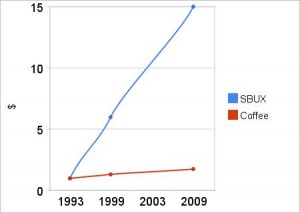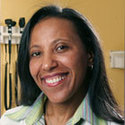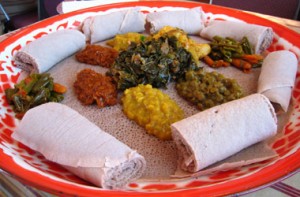Above: Teff is gluten free and known for its flood and drought
resistance. This year 150 acres was planted in Kansas, down
from the 250 acres projected due to untimely rains. (Injera)
By Roxana Hegeman
WICHITA, Kan. (AP) – When black farmers in Kansas first began growing an Ethiopian cereal grain known as teff five years ago, they were intrigued by the crop’s connection to Africa.
Now, the Kansas Black Farmers Association is working with conservationists to expand test plots of teff into market-sized fields that farmers across the state can plant as an alternative crop.
“We get calls monthly from people wanting any teff we have so they can mill it for food,” said Darla Juhl, coordinator for the conservationists group, Solomon Valley Resource Conservation and Development Area. Some of those calls have come from people as far away as the Netherlands and Mexico.
Teff is gluten free and known for its flood and drought resistance. Read more.
Related from Tadias Archives:
Teff luck: What Has Piracy Got To Do With The Price of Injera?

Above: The media never resists stories of sea attacks, but
there is another type of piracy that hardly gets attention:
the looming intellectual property warfare in Africa.
Tadias Magazine
By Nemo Semret
Published: Sunday, January 31, 2010
New York (Tadias) – A few months ago, three Somalis pirates were at the center of world news as they haplessly tried to extort money from an American ship in the Indian Ocean. Three guys coming out of an anarchic isolated part of the world, risked their lives at sea. Two were killed and one now faces the death penalty in the US. Around the same time, three Swedes were found guilty of piracy — as in facilitating the sharing of copyrighted material on the Internet. In the widely publicized case of The Pirate Bay, a Bittorrent index service, three techies with the digital world at their fingertips, thumbed their noses at the law and faced, at worst, some time in the notoriously comfortable jails of Sweden.
The obvious analogy and contrast between these two stories is of course an easy target of ironic comment: piracy, old/new, physical/digital, poor/rich. But it also got me thinking about longer term connections. Indeed, which of those two events is more important symbolically for the future political economy of Africa? Which has more to do with the price of injera or ugali?
Armed men attacking ships at sea was a curious manifestation of the 18th century popping up in the 21st century. Western media and comedians in particular reacted to it as they would to a woolly mammoth buried in the permafrost of Siberia for 10,000 years suddenly thawing and starting to ramble around, Jurrassic Park-style. A pirate story is hard to resist, pirates captivate the imagination of kids, they make western adults feel smug about their own “more civilized” society where such things disappeared 200 years ago, but they also have a kind of radical chic, there’s a certain coolness to their image as rebels standing up to “the man”. They are many interesting things, but there’s also a less exotic reality: those pirates are increasing the cost of shipping anything through that part of the Indian Ocean, which in turn affects the cost of everything from food to energy in Somalia, Djibouti, Ethiopia, Kenya, Tanzania and even further inland, endangering the livelihood of millions of people in the region. Like drug traffickers, in reality they harm not only the world at large but mostly their own people. Unfortunately there’s nothing new about that. In fact, the story of Somali pirates over the last few years fits with the well-worn gloom and doom scenarios of Africa in the 21st century: failed states, increased marginalization, the danger of slipping into a modern dark ages, etc. you know the story.
But how about those Swedish Internet pirates? What do they have to do with Africa, where copyrights and patents have never been respected, and where there isn’t enough bandwidth for it to matter on the global scale anyway? A lot actually. It has got to do with something huge that is quietly reshaping the world: the ever expanding scope of intellectual property. Ok, just in case that was not emphasized enough, this is the thing we’re talking about: the expanding scope of intellectual property. The digitization of entertainment and the difficulties that industry faces from file-sharing are merely the tip of the iceberg. By now it’s old news that, thanks to technology, things that were previously easier to limit and control are now easy to copy and share. But also and more importantly, many things which previously were “free” are now going to get entangled in webs of patents, copyrights, trademarks, and so on. And now we are entering the phase where this will profoundly affect the lives of all of humanity, not just the world of computers and information.
Digital coffee – a trip down memory lane

Years ago (”Digital Coffee”, Nov. 1999), I tried to make the link between coffee and intellectual property, using a comparison of buying $1 of Starbucks stock versus $1 of coffee on the commodity markets. So let’s see where we are today with that hypothetical $1. As illustrated in the chart, invested in SBUX stock in 1993, it grew to $6 by 1999, and would be worth $15 in 2009. While the poor dollar invested in coffee itself, which had reached $1.30 in 1999, would continue to inch up, reaching $1.75 by 2009. The conclusion that, if you consider the chain of value that leads to a cup of coffee, “at the end of the chain it’s $100 a pound, while on the commodity markets it’s $1 a pound, and the grower probably gets $0.10”, has been exacerbated. The coffee farmer, despite doing the most difficult part, gets a shrinking share of the total value. Most of the value in the final product of coffee is really information; it’s in the distribution, and marketing of the coffee experience. That “information goods” part of coffee, which is intellectual property even if it’s not rocket science, is worth more and more while the physical commodity is worth relatively less and less. (That doesn’t happen with oil because there’s a finite supply). And it’s a huge market as I pointed out then, coffee is second only to oil among the world’s commodities in total value. Therefore the producers needed to figure out ways of get in on the information goods game.
Fortunately, awareness of this reality has increased dramatically in recent years. For example, a movie called “Black Gold ” brought some attention to the plight of coffee farmers in the global economy. The Ethiopian Intellectual Property Office engaged it in earnest, staked a claim in the digital coffee realm by trademarking some of the Ethiopian coffee names. Starbucks correctly identified this move as encroaching on their territory (the “information goods” side of coffee) and this caused a huge battle which was widely covered. With the help of organizations like Oxfam, the EIPO managed to move the battle to the court of public opinion. Thus Starbucks an extremely successful western corporation of whose brand “social responsibility” is a core part, whose customers are the very stereotype of the bleeding heart liberal, found itself in the position of the big bad exploiter of poor third world farmers. It was a strategy worthy of Sun Tzu’s Art of War: if you are a smaller, move the battle to a territory where your enemy’s superior firepower is worthless. Game over. Starbucks capitulated, and EIPO got not only the trademarks, but a promise from Starbucks to help the country in more ways than before. My hat goes off to EIPO and Oxfam for this.
Would you rather collect rent or charity?
But coffee is only one example. A dutch company called “Soil & Crop Improvement BV” is patenting a method of processing of teff flour. The invention results in a gluten-free flour, which helps people with Celiac disease. Celiac is a common genetic disorder, affecting people all over the world. For example in the United States, more than 2 million people have the disease. The disease makes the victim unable to eat gluten, a protein that is found in wheat, rye, and barley, which covers a pretty large fraction of the typical western diet. Thus gluten-free food has a huge market. Sounds like there might be a lot of money to be made from Teff!
So let’s see what this patented invention consists of. As far as I can tell, it has two main ideas. First, you wait a few weeks after harvest before grinding the teff, so that the “the amount of undigested sugars in the starch” is lower than it would if the grain was ground immediately. Second, you pass it through a sieve, so only the small grains go through. Pretty simple stuff. Which of course is good! Saving lives is great, and simple solutions that save lives are the best. Except the whole patenting thing… You see, there’s this thing called “prior art”. In the many centuries since Teff has been the staple in Ethiopia, surely someone had the idea of waiting a few weeks before grinding it and taking the finer grain! But those ideas now belong to a dutch company, because the Netherlands has the intellectual property infrastructure that Ethiopia doesn’t. The winner is determined not necessarily by an actual innovation but by things like having patent offices, and membership in the World Traded Organization. So if this works out and it turns out that 100 million Celiac disease sufferers will switch to a Teff-based diet, the bulk of the profits will flow to the dutch company, not the Ethiopian teff farmer. Sound familiar? SBUX redux. Except in this case it might even go further. It’s not “just” a marketing and distribution advantage which gives a larger slice of the total value, the patent owner can actually bloc the farmer entirely out of that market!
Now there’s nothing particularly evil about Soil & Crop nor is there about Starbucks. In fact, for what it’s worth, they both seem to try to be “socially responsible” corporations. But there’s a big difference between charity and obligation. Suppose you own a house and a tenant came to you and said: “let me take your house and in exchange, each month that I earn more than I spend, I promise to share some the excess to help your kids go to school, and buy you some gifts” You’d say: “Wow, thanks you are very generous Mr. Potential Tenant. But no thanks, here’s a lease, just sign here and pay me the rent.” Right? In other words, you would prefer to have a profitable business relationship with them, rather than accept their charity. So why, when it comes to multi-billion dollar markets for living products that are indigenous, why should it be considered OK that companies can own the brand, the patents, and all the associated information goods value, thus controlling 90% of the final value, while tossing the original owners a few crumbs of charity? Why is enough for them to make the profits and “give back” on a discretionary basis? Shouldn’t they pay rent instead of give charity? So perhaps the “digital coffee” conclusion didn’t go far enough. Now commodities are not just becoming information i.e. controlled by branding and marketing, they are becoming intellectual property, through copyrights and patents too. But who owns this property and who should own it?
Even the birds and the bees
This question affects more than just the potential export markets. The owners of the intellectual property can actually come and extract money even from people who were doing the same thing they’ve been doing before the patent ever existed! For example, in a famous case, some farmers in Canada are forbidden from growing crops that they use to grow — rapeseed (canola) — because they might accidentally mix patented seeds into their crops. Even if they don’t want to use the new seeds and try to avoid it, because birds and bees (and wind among other things) will accidentally mix seeds over large distances, the farmers will infringe on these patents that belong to Monsanto and have to stop…. even though they are only doing the same thing they did before the patent. They have effectively been check-mated out of their own traditional business.
You might think that could never happen in Africa right? The very idea of enforcing a patent against a farmer in rural Africa seems laughable. But think ahead. Intellectual property is a key condition to participating in World Trade Organization and the international community in general. Even China is being forced to do something about copyrights to please the WTO. Not being part of WTO is a huge handicap, and Ethiopia is trying hard to get in, like any country that wants to be part of the world economy. So at some point, it’s quite possible that Ethiopians could find themselves in the position of having to choose between accepting the established intellectual property system under which they are screwed, or rejecting the system at enormous costs i.e. going the pirate route.
Which brings us back to our Swedish pirates. Putting aside their guilt or innocence, they exist because a huge number of people feel locked out of the “information goods” and these people create an enormous black market for copyrighted movies, music, and software. And bittorrent, the protocol their service facilitates, just happens to be the most efficient current form of file sharing, so they are current poster children, the latest incarnation of Napster, in the on-going saga of intellectual property on the Internet. But it’s not just pirates. The world of property in information is a dangerously unstable one even among the big players. A long time ago, a researcher from IBM explained the world of corporate patents to me as follows. Patents are like nuclear weapons, they don’t want to use them but they have to have them because their opponents have them. They hold them as deterrents, they sign patent “treaties” where they agree not to sue each other and cross-license patents to each other. But sometimes they actually use these “nuclear weapons” i.e. they sue: vast sums of money are extorted, untold hours of effort are expended in futile wars, and companies are driven out of business, etc.
So if things like coffee and teff are going to become information goods, then what kind of world are we heading into? If you extrapolate from other areas where intellectual property dominates, namely software, digital entertainment, and pharmaceuticals, the current trends do not bode well for the vast majority of humanity. It’s a world where the rich get richer and the poor get poorer, much faster than what has occurred with physical commodities over the last couple of centuries. Those who are locked out of the web of intellectual property ownership will be like non-nuclear powers in a nuclear world, except the super-powers won’t be a stable pair, it will be a multi-polar unstable world, with constant threats and actual disastrous fallouts… and of course pirates! Imagine a world of patented food, and the inevitable black market like narcotics today but much much bigger.
But are we really heading toward this dystopian future of bio-patent wielding powerhouses dominating the world, alternately fighting each other and enslaving the rest? Well of course not necessarily. Fortunately, some farsighted people are already on the case some scientists are calling for a bio-patent ban for example. One of them in fact is an Ethiopian. These are scientists, so of course they are not against scientific advancements and their practical use; they are protesting some forms of ownership. Maybe there will be open-source bio-technology and pharmaceuticals, that are as successful and significant as open source software, and all the key processes and ideas of future life will be freely or fairly available to the whole world. But maybe not. What if that open-source nirvana fails to occur? Banning bio-patents may not be the right answer anyway. Until the right balance emerges in this “informationalization” of everything, all sides have to arm themselves to the teeth for intellectual property warfare lest they be marginalized and reduced to piracy. We are probably already in the early stages of a mad scramble, just like the scramble for African raw materials during the industrial revolution/colonial era. Now it’s not grabbing land with timber and gold but about claiming as much as possible of the DNA of plants and animals, patenting potentially lucrative variations of traditional processes… In the case of Ethiopia for example, it’s not just coffee and teff, it’s also (to take random example, I’m sure there are many more) flaxseed, an important source of Omega-3 acids. Hey has anyone filed a patent for a process to create a convenient form of Telba?












